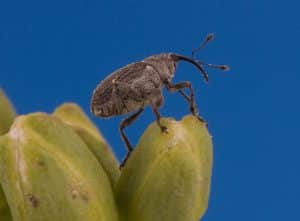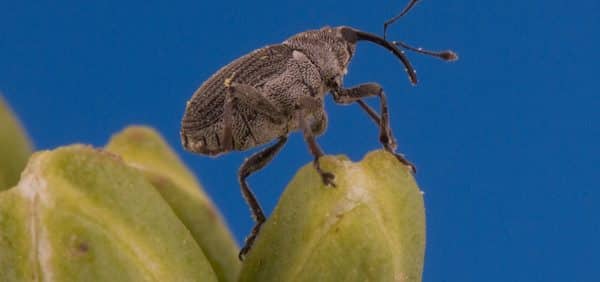Cabbage seedpod weevils do most of their damage by laying eggs in young pods. Larvae emerging from these eggs eat seeds inside the pods, causing the yield loss that can make cabbage seedpod weevil (CSPW) a costly pest in canola.
Keys to the spray decision are scouting and timing. The economic threshold is 20-40 CSPW per 10 sweeps generally across the field. If weevils are at thresholds, the time to spray is at 10-20% bloom. Egg laying begins when pods reach 3/4″ long. A few eggs laid in the first pods is better than spraying too early and not getting good control of high CSPW populations as they move into your fields.

Spraying early. CSPW will feed on buds but this damage rarely causes economic loss, unless the plant is having a hard time flowering at all. There is some interest in spraying them at this stage, but we don’t have research on whether spraying this early has any benefit to the crop or control of CSPW. When scouting at the bud or any stage, sweep well into the field. Numbers tend to concentrate at field edges, so what may seem like high numbers may not be that high throughout the field. If choosing to spray at the bud stage anyway, leave check strips to see if it made economic sense. Keep in mind that cabbage seedpod weevils are good fliers and big populations can descend on a field once it starts to flower — regardless whether that field was already sprayed.
Weevil spread. Years with good canola growing conditions tend to be the years when cabbage seedpod weevil expands its territory the most. Cabbage seedpod weevil was first noticed in canola in southern Alberta. It has since moved north into central Alberta and east into southwest Saskatchewan. Weevils are now found north and east of Regina, and up to the North Saskatchewan River at low numbers. Growers in fringe areas will want to familiarize themselves with the weevil and look for it in their fields.
Further reading:
Cabbage seedpod weevil: When to spray
Saskatchewan’s 2015 cabbage seedpod weevil map

